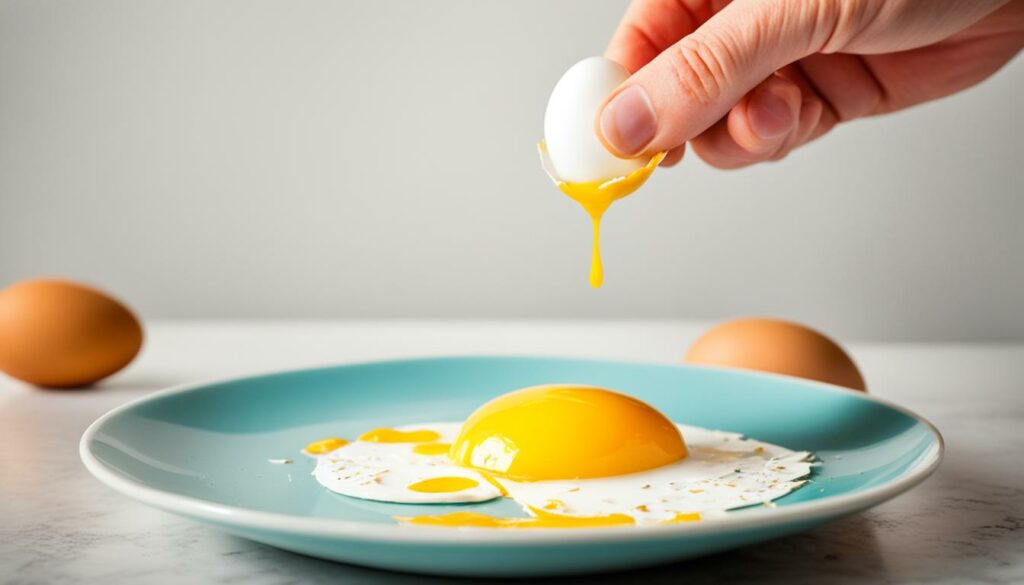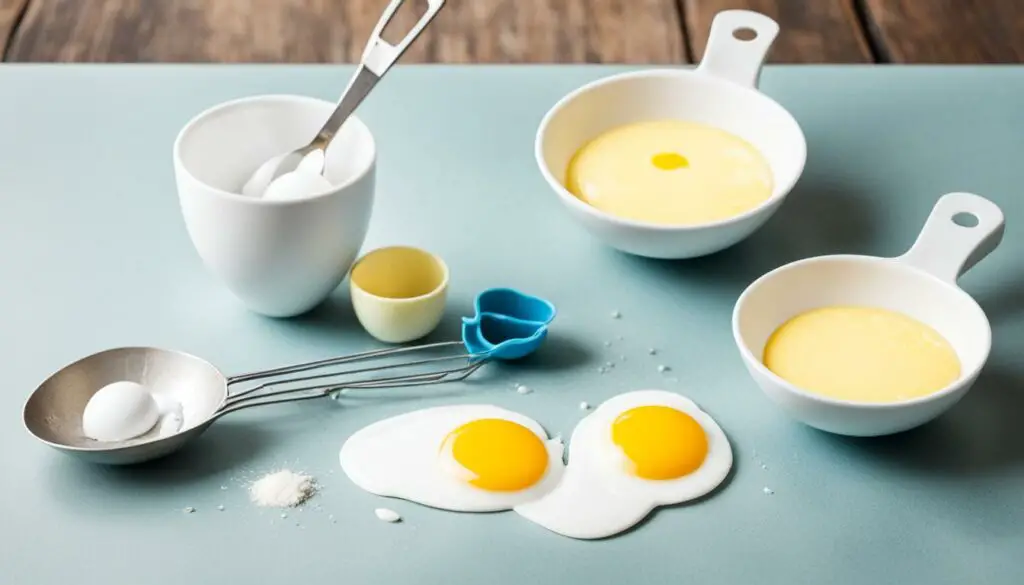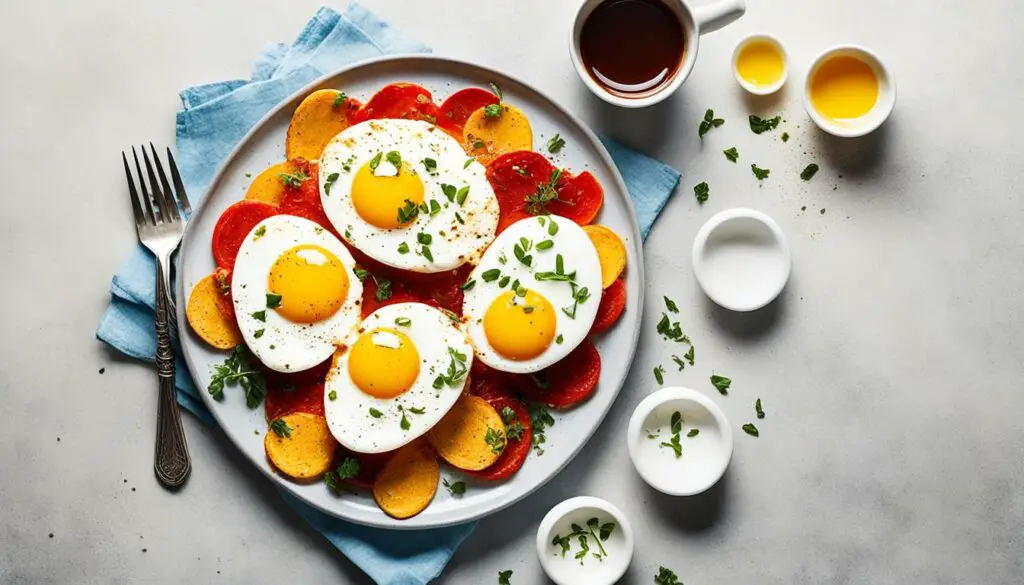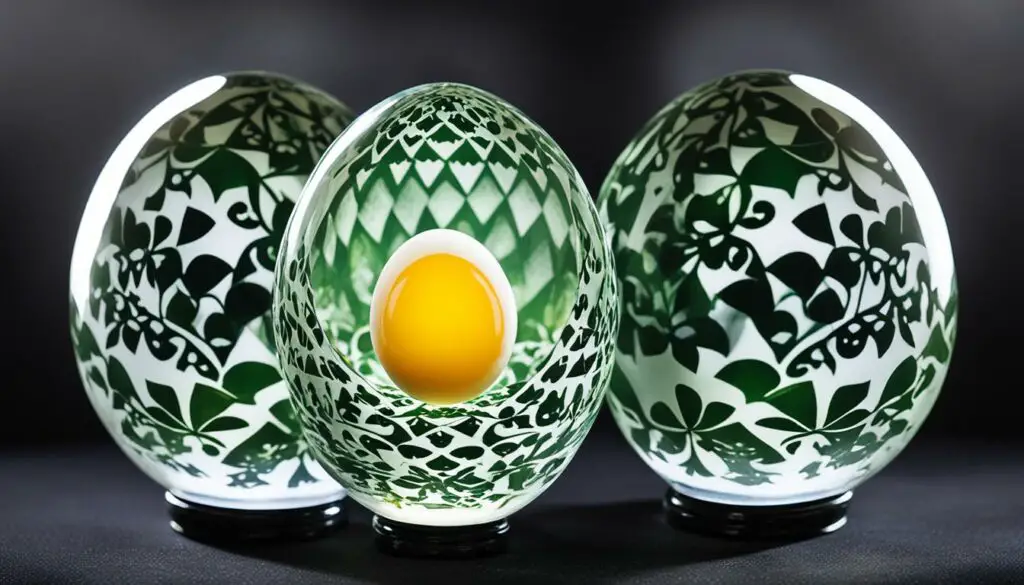Originally posted on March 26, 2024 @ 7:31 pm
Have you ever cracked open an egg and discovered not one, but two bright yellow yolks staring back at you? It’s a surprising sight, but what does it mean for your recipes? How does a double yolk egg affect a recipe? Let’s explore the culinary implications of these intriguing eggs and discover some cooking tips for using them to their fullest potential.
Double yolk eggs are a natural occurrence and are not a cause for concern. They are typically laid by young hens that are just starting to lay eggs. The presence of two yolks in the egg does not affect the safety or nutritional value of the egg. Farmers and egg graders use a process called candling to detect double yolk eggs. Double yolk eggs can be used in cooking and baking with a few adjustments to recipe measurements.
Contents
- 1 Why Do Double Yolk Eggs Occur?
- 2 How to Identify Double Yolk Eggs
- 3 The Frequency of Double Yolk Eggs
- 4 Double Yolk Eggs and Recipe Adjustments
- 5 Double Yolk Eggs and Nutrition
- 6 Double Yolk Eggs and Taste
- 7 Superstitions and Beliefs Surrounding Double Yolk Eggs
- 8 Can Double Yolk Eggs Be Prevented or Induced?
- 9 Conclusion
- 10 FAQ
- 10.1 How does a double yolk egg affect a recipe?
- 10.2 How do you cook with double yolk eggs?
- 10.3 What are some cooking tips for using double yolk eggs?
- 10.4 Why do double yolk eggs occur?
- 10.5 How can farmers identify double yolk eggs?
- 10.6 How often do double yolk eggs occur?
- 10.7 Can you use double yolk eggs in recipes?
- 10.8 Are double yolk eggs healthy?
- 10.9 Do double yolk eggs taste different?
- 10.10 What are some superstitions and beliefs surrounding double yolk eggs?
- 10.11 Can double yolk eggs be prevented or induced?
- 11 Source Links
Key Takeaways:
- Double yolk eggs are a natural occurrence and do not affect the safety or nutritional value of the egg.
- Young hens that are just starting to lay eggs are more likely to produce double yolk eggs.
- Farmers use candling to detect double yolk eggs.
- When using double yolk eggs in recipes, it is important to adjust the measurements accordingly.
- Double yolk eggs have the same taste as single yolk eggs despite their larger size.
Why Do Double Yolk Eggs Occur?
Double yolk eggs are a fascinating natural phenomenon that has puzzled many egg enthusiasts. The mechanics behind the occurrence of double yolk eggs can be attributed to various factors.
One of the main reasons for double yolk eggs is the hen’s reproductive system releasing two yolks at the same time. This can happen due to hormonal changes, a hyperactive ovary, or the hen’s age. It is more common in young hens and certain breeds of chickens.
While the exact mechanics of double yolk egg formation are not fully understood, it is believed that a hormonal disruption during the egg formation process leads to the development of two yolks instead of one. As the egg moves through the hen’s reproductive system, it gathers layers of egg white and shell, resulting in a larger egg with two distinct yolks.
The odds of obtaining a double yolk egg are relatively low, estimated to be around one in every thousand eggs. However, the frequency may vary depending on factors such as the hen’s age and breed.
It is important to note that double yolk eggs are a natural occurrence and do not indicate any problems with the hen or the egg. They are simply a fascinating quirk of nature that adds excitement to the egg-laying process.
For a visual representation of the mechanics behind double yolk eggs, refer to the following diagram:
Factors Influencing Double Yolk Eggs
| Factors | Description |
|---|---|
| Hormonal changes | A disruption in the hen’s hormonal balance during the egg formation process can lead to the release of two yolks. |
| Hyperactive ovary | In some cases, a hen may have a hyperactive ovary, resulting in the simultaneous release of two yolks. |
| Hen’s age | Double yolk eggs are more common in young hens that are just starting to lay eggs. |
| Breed | Certain breeds of chickens are more prone to producing double yolk eggs. |
How to Identify Double Yolk Eggs

Farmers and egg graders use a process called candling to identify double yolk eggs. Candling involves passing the eggs over a bright light that illuminates the interior of the egg, allowing graders to see its contents.
Double yolk eggs can be easily identified during the candling process. They appear larger and more elongated compared to regular single yolk eggs. The size difference is a key characteristic that allows farmers and graders to distinguish double yolk eggs from the rest.
However, it’s important to note that not all double yolk eggs may be detected through candling due to individual variations in size. Some double yolk eggs may go unnoticed if they fall within the normal range of egg sizes.
Sample Table: Comparison of Single Yolk and Double Yolk Eggs
| Feature | Single Yolk Eggs | Double Yolk Eggs |
|---|---|---|
| Size | Standard size | Larger and elongated |
| Yolk Content | One yolk | Two yolks |
| Consistency | Normal | May alter recipe consistency |
| Nutritional Composition | Similar to regular eggs | Slightly higher protein, fat, and cholesterol |
The Frequency of Double Yolk Eggs
While double yolk eggs can be an exciting surprise when cracked open, they are actually relatively rare in the overall egg production. On average, double yolk eggs occur in about one out of every thousand eggs. However, it’s important to note that the likelihood of finding a double yolk egg can vary depending on factors such as the breed and age of the hen.
Young hens that are just starting to lay eggs are more likely to produce double yolk eggs than older hens. This is because their reproductive systems are still maturing, sometimes resulting in the release of two yolks at once. As hens mature, the frequency of double yolk eggs tends to decrease.
| Breed of Hen | Likelihood of Double Yolk Eggs |
|---|---|
| Ameraucana | 1 in every 700 eggs |
| Rhode Island Red | 1 in every 800 eggs |
| Leghorn | 1 in every 900 eggs |
| Plymouth Rock | 1 in every 1000 eggs |
Table: Frequency of Double Yolk Eggs by Hen Breed
As shown in the table above, different breeds may have varying likelihoods of producing double yolk eggs. For example, Ameraucana hens have a slightly higher chance of laying double yolk eggs compared to other breeds.
While double yolk eggs are not as common as single yolk eggs, their rarity adds to their intrigue and makes them a special find for those lucky enough to come across them.
Double Yolk Eggs and Recipe Adjustments

When incorporating double yolk eggs into your recipes, it’s essential to make the necessary measurements adjustments. Double yolk eggs typically contain more yolk than single yolk eggs, which can impact the consistency and texture of your dishes. To compensate for the extra yolk, consider slightly decreasing the number of eggs or adjusting the ratio of other ingredients.
Experimentation may be required to achieve the desired results when using double yolk eggs in your cooking and baking. However, with a few simple adjustments, you can make the most of these unique eggs and enhance the flavor and texture of your dishes.
One way to adapt your recipes is by slightly reducing the number of double yolk eggs used. For example, if a recipe calls for four single yolk eggs, you can substitute two double yolk eggs instead. This adjustment takes into account the higher yolk content and helps maintain the desired balance of ingredients.
Another option is to adjust the ratio of other ingredients to account for the extra yolk. For example, if a recipe requires additional moisture, such as milk or oil, you can slightly reduce the quantity to maintain the desired consistency. Additionally, adjusting the amount of flour or other dry ingredients can help balance the texture of your dishes.
It’s important to note that different recipes may require different adjustments based on factors such as the desired texture, flavor, and desired outcome. The key is to experiment and find the right balance that works best for your specific recipe and taste preferences.
Recipe Adjustment Example:
Here’s a simple example to illustrate how to adjust a recipe when using double yolk eggs:
| Original Recipe | Adjusted Recipe |
|---|---|
| 3 single yolk eggs | 2 double yolk eggs |
| 1 cup flour | 1 cup flour (may need slight adjustment based on texture) |
| 1/2 cup milk | 1/3 – 1/4 cup milk (adjust based on desired consistency) |
| 1/4 cup vegetable oil | 1/4 cup vegetable oil (may need slight adjustment based on desired moisture) |
| … | … |
By making these adjustments, you can ensure that your recipes turn out delicious and perfectly balanced, even when using double yolk eggs.
Double Yolk Eggs and Nutrition
Double yolk eggs are just as healthy and nutritious as single yolk eggs. While there may be slight differences in protein, fat, and cholesterol levels between double yolk eggs and single yolk eggs, these variances are minimal and generally not significant enough to impact most people’s diets or health.
Eggs, regardless of yolk count, are an excellent source of high-quality protein, essential vitamins, minerals, and other nutrients. They provide a range of nutrients, including vitamin B12, vitamin D, riboflavin, choline, and selenium. These nutrients play important roles in supporting overall health, brain function, eye health, and energy production.
Here is a comparison of the nutritional value of double yolk eggs and single yolk eggs:
| Nutrient | Double Yolk Eggs (per 100g) | Single Yolk Eggs (per 100g) |
|---|---|---|
| Protein | 13 g | 12 g |
| Fat | 9 g | 8 g |
| Cholesterol | 539 mg | 373 mg |
| Vitamin B12 | 1.95 μg | 1.95 μg |
| Vitamin D | 1.55 μg | 1.55 μg |
| Riboflavin | 0.3 mg | 0.26 mg |
| Choline | 251 mg | 252 mg |
| Selenium | 31.8 μg | 30.2 μg |
As seen in the table above, double yolk eggs may have slightly higher levels of protein, fat, and cholesterol compared to single yolk eggs. However, the differences are minimal and unlikely to have a significant impact on overall health when consumed as part of a balanced diet.
It’s important to note that individual nutritional needs may vary, and dietary considerations should be discussed with a healthcare professional or registered dietitian.
Double Yolk Eggs and Taste

When it comes to taste, double yolk eggs are no different from single yolk eggs. The chemical properties in both the yolks and whites are the same, resulting in an indistinguishable flavor and texture. So, whether you crack open a double yolk egg or a single yolk egg, you can expect the same delicious taste!
However, it’s important to note that double yolk eggs have a higher yolk content compared to single yolk eggs. This increased yolk amount can potentially affect the consistency of batters or mixtures when used in recipes. To achieve the desired results, it’s recommended to make adjustments to the recipe accordingly.
Whether you’re making a fluffy omelette or a decadent cake, adjusting the recipe measurements can ensure that you achieve the perfect texture without compromising on taste. By making slight modifications to the amount of other ingredients or decreasing the number of eggs used, you can maintain the balance and achieve the desired outcome.
Embrace the versatility of double yolk eggs in your culinary creations and explore the countless delicious possibilities they offer!
Remember, there’s no need to worry about a distinctive taste when using double yolk eggs. Enjoy the same wonderful flavor and texture as you would with single yolk eggs while relishing the uniqueness they bring to your dishes.
Superstitions and Beliefs Surrounding Double Yolk Eggs

Throughout history, double yolk eggs have captured the imagination and given rise to intriguing superstitions and beliefs in various cultures. While these beliefs are rooted in cultural folklore, it is important to note that they do not have any scientific basis. Let’s explore some of the fascinating superstitions and beliefs associated with double yolk eggs.
The Sign of Impending Death in Norse Mythology
“In Norse mythology, the appearance of a double yolk egg was believed to be a foreboding sign of impending death. It was seen as a bad omen, symbolizing the imminent departure of a loved one. This superstition highlights the significance placed on double yolk eggs and their impact on people’s beliefs and fears.”
Symbol of Good Luck and Fertility
In contrast to Norse mythology, other cultures view double yolk eggs as symbols of good luck and fertility. In these cultures, discovering a double yolk egg is considered a fortunate event, believed to bring blessings and prosperity to the individual or family. It is seen as a promising sign and an indication of future success.
The association of double yolk eggs with fertility is particularly prevalent, with some believing that consuming these eggs can enhance the chances of conception or promote a healthy pregnancy. This belief aligns with the symbolism of the egg as a potent life-giving symbol.
Embracing Cultural Folklore
Superstitions and beliefs surrounding double yolk eggs provide a fascinating glimpse into the diverse traditions and cultural heritage of different societies. They reflect the human tendency to find meaning and significance in everyday occurrences, including the discovery of a double yolk egg.
While these superstitions and beliefs may not be grounded in scientific evidence, they contribute to the rich tapestry of cultural customs and traditions around the world. Whether seen as a harbinger of doom or a herald of good fortune, double yolk eggs continue to captivate our imagination and spark conversations about the mystical in the mundane.
Can Double Yolk Eggs Be Prevented or Induced?
Double yolk eggs are a natural occurrence and cannot be prevented or induced. They are a result of the hen’s reproductive system releasing two yolks at the same time. As hens mature, the frequency of double yolk eggs typically decreases. However, even older hens can occasionally lay double yolk eggs. It is important to note that double yolk eggs are safe to eat and do not indicate any problems with the egg or the hen.
Why Can’t Double Yolk Eggs Be Prevented or Induced?
Double yolk eggs are not a condition or abnormality that can be controlled or intentionally triggered. They are a natural result of the hen’s reproductive cycle. When a hen is ready to lay an egg, her ovary releases a yolk into the reproductive tract. Occasionally, the hen’s reproductive system may release two yolks simultaneously, resulting in a double yolk egg. This occurrence cannot be prevented or induced through external factors or interventions.
“Double yolk eggs are a fascinating example of nature’s wonders. While they may surprise and delight us, they are simply a natural part of a hen’s egg-laying process.”
Some people may wonder if there are ways to increase or decrease the likelihood of obtaining double yolk eggs. However, there is no scientifically proven method to control or manipulate the occurrence of double yolk eggs. It is purely a biological process determined by the hen’s reproductive system. Age and breed can influence the frequency of double yolk eggs, with younger hens and certain breeds being more prone to producing them. Nonetheless, these factors cannot guarantee or prevent the occurrence of double yolk eggs.
Are Double Yolk Eggs Safe to Eat?
Double yolk eggs are safe to consume, just like single yolk eggs. The presence of two yolks does not affect the safety or quality of the egg. They undergo the same rigorous quality control measures as other eggs, including inspection and grading. It is important to handle all eggs, whether single or double yolk, with proper food safety practices such as refrigeration, cooking thoroughly, and avoiding cracked or damaged shells.
Frequency of Double Yolk Eggs by Hen Age
| Hen Age | Frequency of Double Yolk Eggs |
|---|---|
| Young Hens (under 6 months) | Higher frequency |
| Adult Hens (6 months to 1 year) | Moderate frequency |
| Older Hens (over 1 year) | Lower frequency |
Note: The frequency of double yolk eggs can vary among individual hens and is influenced by factors such as breed, genetics, and overall health.
In conclusion, double yolk eggs are a natural occurrence and cannot be prevented or induced. They are a fascinating example of nature’s wonders and pose no harm or safety concerns. Whether you come across a double yolk egg in your egg carton or while cooking, embrace the uniqueness and enjoy the culinary possibilities they offer.
Conclusion
Double yolk eggs are a fascinating natural occurrence that can add a unique twist to recipes. Despite the presence of two yolks, double yolk eggs do not pose any safety or nutritional concerns. They can be used in cooking and baking, although adjustments may be needed in recipe measurements to maintain the desired consistency.
When it comes to health benefits, double yolk eggs offer the same advantages as their single yolk counterparts. They are a rich source of high-quality protein, essential vitamins, minerals, and other nutrients. Whether you stumble upon a double yolk egg as a lucky surprise or it’s a regular occurrence in your flock, embrace the uniqueness and explore the creative culinary possibilities they offer.
So, the next time you crack open a double yolk egg, don’t be surprised. Instead, appreciate the wonder of nature that has produced such an egg and savor the delicious dishes it can help create. Double yolk eggs are a delightful addition to any kitchen, allowing you to enjoy the goodness and flavors they offer.
FAQ
How does a double yolk egg affect a recipe?
Double yolk eggs contain more yolk content, which can affect the consistency and texture of recipes. Adjustments in recipe measurements may be needed to achieve the desired results.
How do you cook with double yolk eggs?
Double yolk eggs can be used in cooking and baking by adjusting the recipe measurements. Slightly decreasing the number of eggs or adjusting the ratio of other ingredients can help compensate for the extra yolk.
What are some cooking tips for using double yolk eggs?
When cooking with double yolk eggs, it is recommended to experiment and adjust the recipe accordingly to achieve the desired results. Some trial and error may be needed to find the right balance of ingredients.
Why do double yolk eggs occur?
Double yolk eggs occur when a hen’s reproductive system releases two yolks at the same time. This can happen due to hormonal changes, a hyperactive ovary, or the hen’s age. It is more common in young hens and certain breeds of chickens.
How can farmers identify double yolk eggs?
Farmers and egg graders use a process called candling to detect double yolk eggs. During candling, the eggs are passed over a bright light that illuminates the interior of the egg. Double yolk eggs appear larger and more elongated than regular single yolk eggs.
How often do double yolk eggs occur?
Double yolk eggs are relatively rare, occurring in about one out of every thousand eggs. The likelihood of getting a double yolk egg can vary depending on factors such as the breed and age of the hen. Young hens that are just starting to lay eggs are more likely to produce double yolk eggs than older hens.
Can you use double yolk eggs in recipes?
Yes, double yolk eggs can be used in recipes. However, adjustments in recipe measurements may be necessary to account for the increased yolk content. Slightly decreasing the number of eggs or adjusting the ratio of other ingredients can help maintain the desired consistency.
Are double yolk eggs healthy?
Yes, double yolk eggs are just as healthy and nutritious as single yolk eggs. While they may have slightly higher levels of protein, fat, and cholesterol, the differences are minimal and generally not significant enough to affect most people’s diets or health.
Do double yolk eggs taste different?
No, double yolk eggs do not taste different from single yolk eggs. The chemical properties in egg yolks and egg whites are the same, so there is no difference in taste or texture. However, the increased yolk content may alter the consistency of batters or mixtures when used in recipes.
What are some superstitions and beliefs surrounding double yolk eggs?
In various cultures, double yolk eggs have been associated with different superstitions and beliefs. In Norse mythology, they were believed to be a sign of impending death. In other cultures, they are seen as a symbol of good luck or fertility. These beliefs, however, are based on cultural folklore and lack scientific basis.
Can double yolk eggs be prevented or induced?
Double yolk eggs are a natural occurrence and cannot be prevented or induced. They are a result of the hen’s reproductive system releasing two yolks at the same time. As hens mature, the frequency of double yolk eggs typically decreases.








